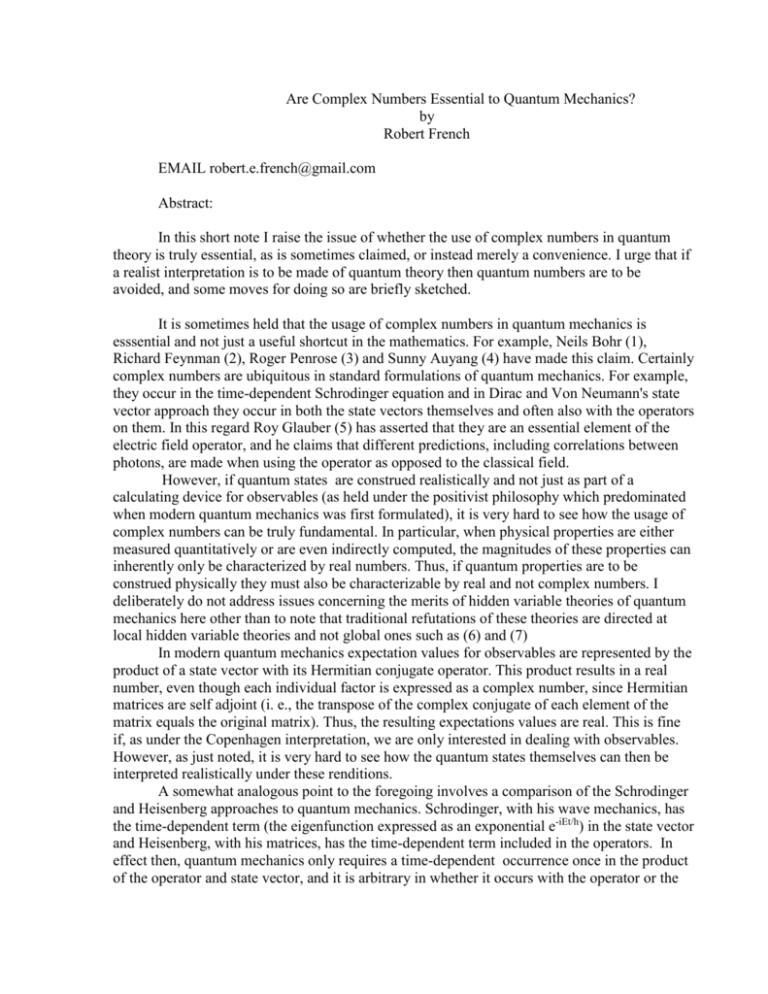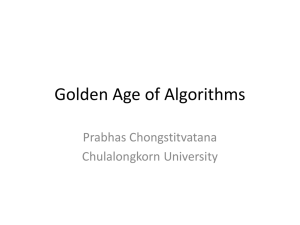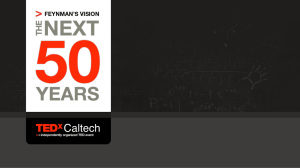Are Complex Numbers Essential to Quantum Mechanics
advertisement

Are Complex Numbers Essential to Quantum Mechanics? by Robert French EMAIL robert.e.french@gmail.com Abstract: In this short note I raise the issue of whether the use of complex numbers in quantum theory is truly essential, as is sometimes claimed, or instead merely a convenience. I urge that if a realist interpretation is to be made of quantum theory then quantum numbers are to be avoided, and some moves for doing so are briefly sketched. It is sometimes held that the usage of complex numbers in quantum mechanics is esssential and not just a useful shortcut in the mathematics. For example, Neils Bohr (1), Richard Feynman (2), Roger Penrose (3) and Sunny Auyang (4) have made this claim. Certainly complex numbers are ubiquitous in standard formulations of quantum mechanics. For example, they occur in the time-dependent Schrodinger equation and in Dirac and Von Neumann's state vector approach they occur in both the state vectors themselves and often also with the operators on them. In this regard Roy Glauber (5) has asserted that they are an essential element of the electric field operator, and he claims that different predictions, including correlations between photons, are made when using the operator as opposed to the classical field. However, if quantum states are construed realistically and not just as part of a calculating device for observables (as held under the positivist philosophy which predominated when modern quantum mechanics was first formulated), it is very hard to see how the usage of complex numbers can be truly fundamental. In particular, when physical properties are either measured quantitatively or are even indirectly computed, the magnitudes of these properties can inherently only be characterized by real numbers. Thus, if quantum properties are to be construed physically they must also be characterizable by real and not complex numbers. I deliberately do not address issues concerning the merits of hidden variable theories of quantum mechanics here other than to note that traditional refutations of these theories are directed at local hidden variable theories and not global ones such as (6) and (7) In modern quantum mechanics expectation values for observables are represented by the product of a state vector with its Hermitian conjugate operator. This product results in a real number, even though each individual factor is expressed as a complex number, since Hermitian matrices are self adjoint (i. e., the transpose of the complex conjugate of each element of the matrix equals the original matrix). Thus, the resulting expectations values are real. This is fine if, as under the Copenhagen interpretation, we are only interested in dealing with observables. However, as just noted, it is very hard to see how the quantum states themselves can then be interpreted realistically under these renditions. A somewhat analogous point to the foregoing involves a comparison of the Schrodinger and Heisenberg approaches to quantum mechanics. Schrodinger, with his wave mechanics, has the time-dependent term (the eigenfunction expressed as an exponential e-iEt/h) in the state vector and Heisenberg, with his matrices, has the time-dependent term included in the operators. In effect then, quantum mechanics only requires a time-dependent occurrence once in the product of the operator and state vector, and it is arbitrary in whether it occurs with the operator or the state vector. As in the case of and its complex conjugate * a product thus must also be taken here in order to create the expectation value (eigenvalue) of an observable. One move that can be made towards avoiding complex numbers in a realist interpretation of quantum mechanics involves noting Euler's identity whereby exponential functions can be rendered trigonometrically as eix = cos(x) + isin(x). It might seem that this just is a compact notation for expressing two orthogonal waves; in particular since when multiplied by the complex conjugate the identity is rendered as cos2(x) + sin2(x). When this is applied to quantum mechanics both waves come into play, since the phase difference, although not the absolute phase matters. Both Penrose (3) and Auyang (4) assert that accounting for this phase difference requires the usage of complex numbers, but it is not at all clear to me why this is the case. In particular, I suggest in (6) that probability amplitudes for both the sine and cosine waves be first individually vectorially summed and the resultants then squared. If the two resultants (which can be identified with energy fields and not force fields) are then summed, it may be possible to get around Penrose and Auyang's point. Admittedly though this issue requires further analysis, particularly in respect to avoiding complex numbers both in probability amplitudes themselves and in their associated operators. Complex numbers are also introduced to factor expressions of the form x2 + y2 into the form (x + iy) x (x - iy). It can be conceded that there is no general algebraic solution to the equation x2 + y2 = z2 . Similarly, a sqaure root for x2 + y2, cannot be expressed in terms of x and y alone (due to the cross term 2xy). Nevertheless, it should be emphasized that there still will be roots for particular numerical here. In other words, for each possible place value which can be substituted for the variables x and z respectively, there will be a place value for y which will make the equation come out true. However, it should also be noted in this case that the place value for y will typically be irrational, and also that there are no standardly defined functions characterizing these relationships. Thus, as with the case of the Euler identity, the usage of complex numbers here would appear to be a matter of convenience rather than of necessity. A connection can be made between the preceding points and properties of the electric and magnetic fields. In particular, in the case of light, it can be noted that the energy density of the electromagnetic fields is given by E2 + B2. When this is factored into (E + iB) (E - iB) a parallel can be noted with the probability amplitudes and its complex conjugate * so as to construct a photon wave function; see Bialynicki-Bibula (8). However, it can be noted that an alternative to factoring the whole expression here would be to add the separate quadratic parts, which can be construed as energy densities (6). In closing, something should be said with respect to the subject of the ontological status of complex numbers. I believe that imaginary number were named "imaginary' with good reason; -1 does not have a square root. Also, complex numbers are not just ordered pairs of real numbers, as is sometimes claimed. This is only true if special rules for multiplying the ordered pairs are included. In particular, (x1, y1)(x2, y2) is defined as equaling (x1x2 - y1y2, x1y2 + x2y1) I want to emphasize that the preceding remarks are not meant to discourage the use of complex numbers in science as a useful shortcut for making calculations such as in factoring certain quadratic equations or in solving many classes of differential equations. However, it must be possible, at least in principle, to cash out this usage in terms of functions not containing complex numbers such as with trigonometric functions. For example, consider the usage in electrical engineering of the imaginary impedance , or the treatment of two-photon absorption in chemistry where the coefficient is proportional to the imaginary portion of the third order non-linear optical susceptibility (3). The physical properties here clearly are not imaginary even if the functions used for characterizing them are expressed in terms of complex numbers. References 1. Neils Bohr, "the Quantum Postulate and the Recent Development of Atomic Theory," in John Wheeler and Wojceich Zurek , Quantum Theory and Measurement (Princeton: Princeton University Press, 1983), p. 111. 2. Richard Feynman, The Feynman Lectures on Physics (Addison Wesley, Reading, MA, 1963) Vol III, pp. 1-6, 7-5 3. Roger Penrose, The Emperor's New Mind (Penguin Books, 1991), p. 236; The Road to Reality (Random House, NY, 2004) Sec. 21.6. 4. Sunny Auyang, How is Quantum Field Theory Possible? (Oxford, Oxford Univ. Press,1995), p. 74 5. Roy Glauber, "The Quantum Theory of Optical Coherence," Physical Review 130, p. 2529, 1963. 6.Robert French, "Wave Particle Unity and a Physically Realist Interpretation of Light" at www.quantumrealism.net. 7. David Bohm, The Undivided Universe (Routledge, London, 1993). 8. Bkialnicki -Bibula, "Photon Wave Function," Progress in Optics 36, pp. 245-293 (1996).







